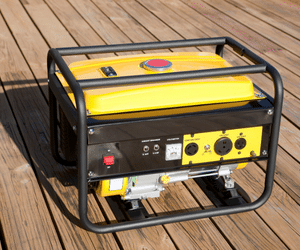How to Calculate What Size Standby Generator Is Best for Your Home

A standby generator can be a great addition to the home that will help keep you protected whenever your power goes out. As soon as the power goes out, the generator will almost immediately start running, and your home’s power will be restored within seconds. If you have a standby generator that is adequately sized and working correctly, it should ensure that your home still has enough electricity to power all of your most important appliances and systems, no matter how long the local electrical grid is out.
Unlike a portable generator that can only work to power something that is directly into the unit, a standby generator is permanently mounted outside the home and wired directly into your home’s electrical system. Portable generators can also be wired into your home, but they can’t be permanently mounted outside, so you will still need to drag the unit out and connect it should your power go out.
Portable generators also don’t provide nearly enough electricity to power your home, whereas a standby generator definitely can. However, it is still essential that your standby generator is the right size. Otherwise, it may not work how you need it to, and here is an overview of everything that is involved in deciding what size of generator is needed.
Why Choosing the Right Size of Generator Is Essential
When choosing a standby generator, it is essential that you have a licensed electrician calculate what size of unit you need. Going with a generator that is much larger than you need isn’t really an issue other than it means you’ll be paying quite a bit more for the unit than is necessary. A generator that is too small for your house is an even bigger waste of money since it likely won’t work when you need it to.
All standby generators are rated to produce a certain amount of power. If anything ever tries to draw more power than the generator can handle, the generator will automatically shut down due to overloading. Overloading will result in the generator’s internal circuit breaker tripping, and the unit will then need to be reset before it will run again. However, if your home is still drawing more power than the generator can handle, the breaker will immediately trip again.
Why the Size of Your HVAC System Is the Biggest Factor to Consider
If your home has a central air conditioning or heating system, this is the main factor that an electrician will focus on when calculating what size generator you need. Central cooling units like air conditioners and heat pumps typically draw far more power than anything else in your home. The one exception is if your home has an electric furnace since these typically require even more energy than an AC.
Depending on what size of AC or heat pump you have and what its energy efficiency rating is, it most likely uses anywhere from 0.5 to 4.5 kilowatts of electricity per hour (kWh). If your home has an electric furnace, it could use anywhere from 10 to 50 kilowatts per hour.
The fact that your HVAC system requires so much power means it is essential that your generator is large enough to power it. If not, the generator will get overloaded as soon as the HVAC system tries to start, and you’ll be left with no power and no heating or air conditioning.
Understanding Load Calculations and Starting Current
The only real way to ensure that your generator is adequately sized is to have a load calculation performed. A load calculation essentially involves going around the home and taking note of how much energy appliances and devices use. This list should include the washing machine, dryer, dishwasher, hair dryer, light fixtures, HVAC system, oven, water heater, and anything else you think you may need during a power outage, such as your computer or TV.
A load calculation is important as it tells exactly how much power your home uses, so you then know how much power your generator needs to provide. The only issue is that motor-driven appliances like your air conditioner, HVAC blower and refrigerator draw far more power in order to start than they do once they’re running. This is known as the starting current, and it is important that the load calculations are always based on this and not the running current.
Let’s say that your home has a 2-ton air conditioner. Depending on the unit’s SEER rating, your AC would typically use somewhere between 1 and 2 kilowatts of electricity per hour. However, the amount of current the unit draws will usually be two to six times the normal amount during the first few seconds when it powers up. If your generator isn’t large enough, this startup current would overload it and cause its circuit breaker to trip instantly. This is why it is so vital that load calculations are always based on starting current instead of the running current. Otherwise, the generator may not be able to meet your needs.
In order to ensure that you have enough power to start and run both a 2-ton AC unit and all of your other important appliances and devices, you will typically need at least a 10- or 11-kWh generator. If your home has a 5-ton AC, you will usually need a generator that produces at least 20 kWh.
How Load Management and Load Shedding Work
Most modern generators have built-in features known as load shedding and load management that work to ensure that the unit doesn’t overload. Essentially, the generator can be programmed to prioritize the most important systems and appliances so that it always has enough power.
Load management means that it will send power to the most important things or the appliances that draw the most energy first. Once these are running, it will then start to send electricity to the lower-priority loads. Since your HVAC system generally requires the most energy, the generator will power it first and then move on to power your refrigerator, water heater, lights, and other necessities.
If any high-priority appliance suddenly calls for more power that could overload the generator, it will then stop powering the lower-priority loads for a short time. This is known as load shedding and is an important feature that helps to ensure the generator won’t get overloaded and shut down. Load shedding most typically happens when your HVAC system has shut off and then needs to turn on again. Since the system requires a lot of energy to start up, the generator will shut off the power to the lower-priority things to prevent possible overloading.
Load management and shedding are essential features as they allow you to get by with a slightly smaller generator than you would otherwise. If your generator didn’t have these features, it would need to be sufficiently large to power everything in your home at one time without potential overloading.
Seattle’s Electrical Service Experts
At Brennan Electric, our licensed electricians have years of experience installing standby generators and will ensure that you get the best unit for your needs. We can also assist with hardwiring your portable generator, installing a whole-home surge protector or any other electrical installation, inspection and repair needs. To learn more about your generator options or to schedule a consultation, give Brennan Electric a call today.

